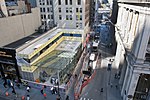The 2022–2023 HarperCollins strike was a labor strike involving about 250 workers for HarperCollins, an American publishing company headquartered in the New York City borough of Manhattan. The workers, members of the United Auto Workers (UAW) Local 2110, went on strike on November 10, 2022, after failing to reach an agreement with the company regarding a new labor contract. The union members returned to work on February 21, 2023, after agreeing to a new contract that addressed many of the concerns they had initially had, including an increase in starting salaries and changes to some work regulations.
HarperCollins is one of the largest publishing companies in the United States. In 2022, it had a global workforce of about 4,000, with about 250 of these employees at their Manhattan headquarters represented by UAW Local 2110. The local union had been established at a predecessor company in the 1940s and was unique as one of the only unions representing white-collar workers in the publishing industry. Beginning in December 2021, the union and company began to negotiate the terms for a new labor contract, as the existing one was set to expire on December 31, though the contract was extended into the following year as negotiations continued. However, by April 2022, the contract fully expired and the company and union were still unable to come to a solid agreement regarding a new contract, with the union requesting increased starting salaries, better union protections, improved parental leave benefits, and a greater commitment from the company to diversity in the workplace. On July 20, about 100 union members staged a one-day strike to protest the company, picketing outside their headquarters at 195 Broadway. In October, union members voted by an overwhelming majority to authorize an open-ended strike, which commenced with picketing on November 10.
From the beginning of the strike, many notable authors, such as Alexander Chee and Lauren Groff, voiced their support for the strikers, and on December 8, about 500 authors signed a letter to executives of the company urging them to negotiate an end to the strike, with many saying they would not be considering the company for publishing any of their works during the labor dispute. By late January 2023, the company and union agreed to federal mediation, which began in early February. On February 9, both sides announced a tentative deal that the union would submit for approval by its members within the next several days. Union members voted to approve the agreement on February 16 and return to work on February 21, bringing an end to the strike.
Union members generally viewed the new contract as a success. The agreement, which would run until December 31, 2025, included, among other things, a gradual increase in starting salaries from $45,000 to $50,000 by 2025, changes to overtime and remote work regulations, and a one-time bonus payment of $1,500 to union members. Union members and several publications also expressed the opinion that the results of the strike could have repercussions for the entire publishing industry, as several other companies agreed to raise their starting salaries around the same time.









